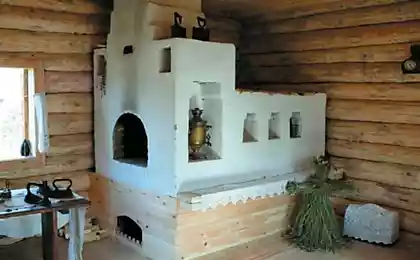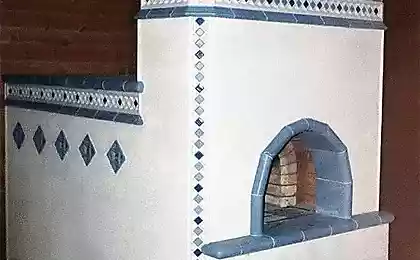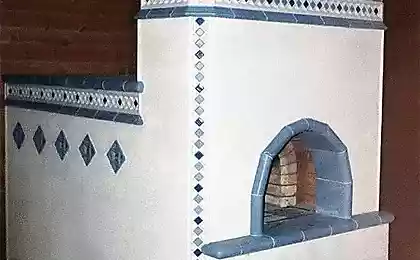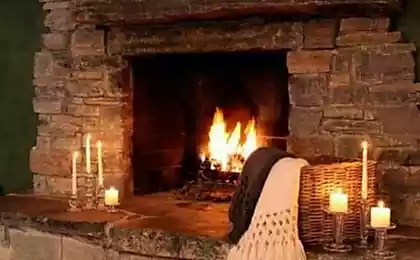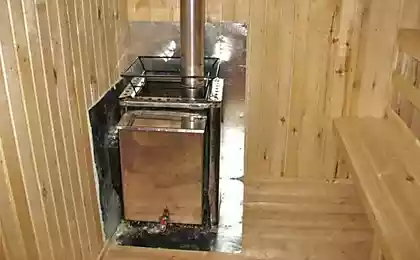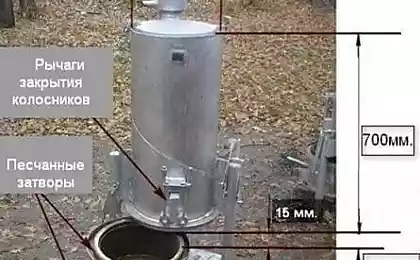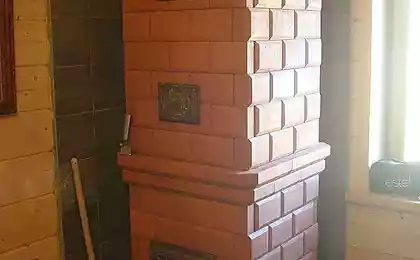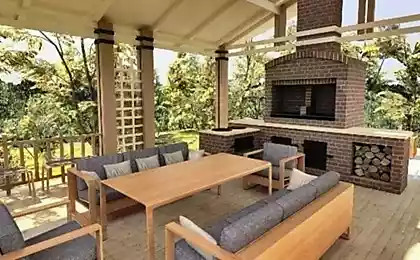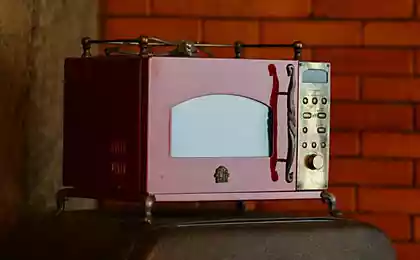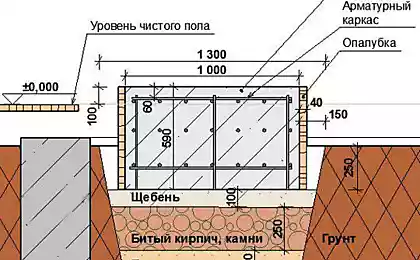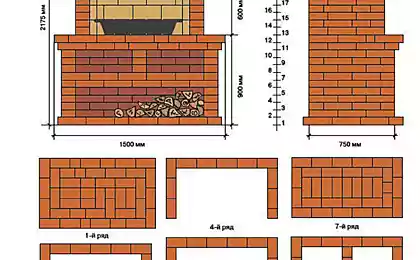684
How to make the right solution for furnace
Useful tips! How to make a good mortar for masonry ovens. Are you surprised? Is there still a bad solution? There are, unfortunately, not always potters-lovers understand it in time, before the masonry of the furnace itself. How to avoid mistakes in the preparation of the solution and to achieve the best results in the work of creation is equally useful as cosy hearth — the two main issues that we are facing today and will try to answer.
Tools and materials
First, and most important for our experiment is to stock up on the necessary material to prepare the solution. Please note, we take not just any water, some sand and clay.
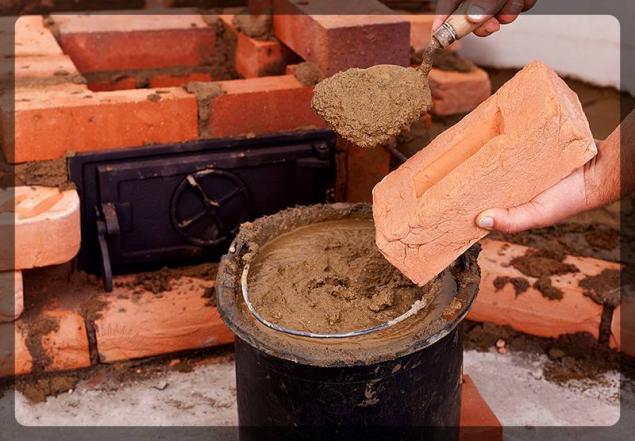
Our ingredients must meet certain requirements:
1. Water. It should be fairly clean, no musty smell, and with low content of mineral salts. If the area has problems with water, not working the column, or from well water gives much Tina take care of her reserves in advance, for preparation of a solution will need more than one bucket. On average, based on 100 bricks, you will need 15-20 litres of water.
2. Sand. We take only the fine sand that must first be carefully screened. For this purpose we need a special sieve for sifting sand. Depending on the clogging of sand, gravel and crushed stone used for sifting a sieve with mesh size from 0, 25 mm to 10 mm. For the fine sand will be enough to use a sieve with a mesh size of 1.5 mm.
3. Clay. It is the quality of the clay that you will use depends entirely on the required amount of sand for mortar. First mix the clay and water until a homogeneous mass. It should be not too thick and not too runny.
The sand begin to add (in the ratio liter cans of sand to one bucket of water) when using a smooth wooden plank will check the resulting solution for the plasticity. Drop the Board into the solution and see what the thickness will be adhering to it a layer of a clay solution. It should not be too thick or too thin. Otherwise added to a solution of sand, periodically checking the solution on the plasticity already known to you way. A layer of a solution on a plate of 2 mm thickness is ideal. And so in the solution was observed the correct proportions of sand and clay. Such a solution during masonry will not be treacherous to stick to your trowel and get to think about a different way to prepare the solution...
However, for the purity of our experiment is worth mentioning a few options for making our solution. Importantly, in the end, "the suit was sitting... easily and impressively" In our case, such "suit" must be a high quality solution, which will not crack in a frozen state, will not shrink, will not break into small pieces in 100-degree temperature and firmly bonded brickwork.
Method for the patient.
In preparation of the solution will take more than a day. The clay is soaked for 24 hours before laying. After this time otmuchow clay added water, just enough to on the surface of the liquid mass of the surfaced lightweight contaminants and heavy settled at the bottom. Then, the resulting solution should drain, add sand and mix well. As a result, as we already know, should get a homogeneous mass.
Way to the strongest.
If by good you got the clay without impurities, it is necessary to add ¼ of water from the total volume of clay, there to load the desired amount of pre-sifted through a sieve fine sand. Future success depends on the strength of your hands, because the process of mixing sand and clay to a uniform weight in this option is very time consuming.
It's all in the boxes.
For the next method, the necessary design of the three boxes with the main components — nets and flaps. First serve for straining, the second — for the production of clay. The design resembles a three-tiered. First the clay is poured into the top tier. Abundantly pour water. All stir. Then open the damper to allow the solution to drain on the grid of the second tier. When the clay will "precipitate", it is also, as in the first two cases, down to the bottom layer. There to the clay (ratio 1:2) add sand. The solution is ready.
To achieve excellence in strength of mortar is sometimes added to salt (100-200 g per bucket of mortar) or concrete (three quarters of a litre per bucket). When this salt is dissolved in water, and the cement is mixed with water to density of sour cream. But how to check the resulting solutions in plasticity, you already know.
Another way, which is worth mentioning is the mixing of mortar with cement. In principle, this method technology is a little different from the usual. Just as the clay acts as cement. It is also mixed with sand. Before you start laying bricks, pour water, bring to desired consistency. And after checking on plasticity (see above), especially without delay, use in the case. Unlike clay, cement mortar stored for long periods impossible.
Also, the structure of mortar for masonry often include, in addition to the listed ingredients, lime and asbestos. He only has one, but significant advantage is quickly grasped. To cure him quite a few minutes.
Way probably one of the most simple: sand, cement, asbestos mixed in dry form. To the received mix add a clay or lime mortar and mix until smooth. Sometimes, for greater fortress, the resulting solution is mixed with a separately prepared a plaster solution.
But remember, whichever method you choose, the best one will be the one that you took the time. published
P. S. And remember, only by changing their consumption — together we change the world! © Join us at Facebook , Vkontakte, Odnoklassniki
Source: green-dom.info/%D0%BE%D1%82%D0%BE%D0%BF%D0%BB%D0%B5%D0%BD%D0%B8%D0%B5-%D0%B2%D0%BE%D0%B4%D0%BE%D1%81%D0%BD%D0%B0%D0%B1%D0%B6%D0%B5%D0%BD%D0%B8%D0%B5-%D0%BA%D0%BE%D0%BC%D0%BC%D1%83%D0%BD%D0%B8%D0%BA%D0%B0%D1%86/kak-sdelat-pravilnyj-rastvor-dlya-pechi/
Tools and materials
- shovel
- iron or wooden receptacle (covered with tin)
- the sieve (size of mesh is 1.5×1.5 mm)
- wooden stick or plank
- a drill-mixer
First, and most important for our experiment is to stock up on the necessary material to prepare the solution. Please note, we take not just any water, some sand and clay.

Our ingredients must meet certain requirements:
1. Water. It should be fairly clean, no musty smell, and with low content of mineral salts. If the area has problems with water, not working the column, or from well water gives much Tina take care of her reserves in advance, for preparation of a solution will need more than one bucket. On average, based on 100 bricks, you will need 15-20 litres of water.
2. Sand. We take only the fine sand that must first be carefully screened. For this purpose we need a special sieve for sifting sand. Depending on the clogging of sand, gravel and crushed stone used for sifting a sieve with mesh size from 0, 25 mm to 10 mm. For the fine sand will be enough to use a sieve with a mesh size of 1.5 mm.
3. Clay. It is the quality of the clay that you will use depends entirely on the required amount of sand for mortar. First mix the clay and water until a homogeneous mass. It should be not too thick and not too runny.
The sand begin to add (in the ratio liter cans of sand to one bucket of water) when using a smooth wooden plank will check the resulting solution for the plasticity. Drop the Board into the solution and see what the thickness will be adhering to it a layer of a clay solution. It should not be too thick or too thin. Otherwise added to a solution of sand, periodically checking the solution on the plasticity already known to you way. A layer of a solution on a plate of 2 mm thickness is ideal. And so in the solution was observed the correct proportions of sand and clay. Such a solution during masonry will not be treacherous to stick to your trowel and get to think about a different way to prepare the solution...
However, for the purity of our experiment is worth mentioning a few options for making our solution. Importantly, in the end, "the suit was sitting... easily and impressively" In our case, such "suit" must be a high quality solution, which will not crack in a frozen state, will not shrink, will not break into small pieces in 100-degree temperature and firmly bonded brickwork.
Method for the patient.
In preparation of the solution will take more than a day. The clay is soaked for 24 hours before laying. After this time otmuchow clay added water, just enough to on the surface of the liquid mass of the surfaced lightweight contaminants and heavy settled at the bottom. Then, the resulting solution should drain, add sand and mix well. As a result, as we already know, should get a homogeneous mass.
Way to the strongest.
If by good you got the clay without impurities, it is necessary to add ¼ of water from the total volume of clay, there to load the desired amount of pre-sifted through a sieve fine sand. Future success depends on the strength of your hands, because the process of mixing sand and clay to a uniform weight in this option is very time consuming.
It's all in the boxes.
For the next method, the necessary design of the three boxes with the main components — nets and flaps. First serve for straining, the second — for the production of clay. The design resembles a three-tiered. First the clay is poured into the top tier. Abundantly pour water. All stir. Then open the damper to allow the solution to drain on the grid of the second tier. When the clay will "precipitate", it is also, as in the first two cases, down to the bottom layer. There to the clay (ratio 1:2) add sand. The solution is ready.
To achieve excellence in strength of mortar is sometimes added to salt (100-200 g per bucket of mortar) or concrete (three quarters of a litre per bucket). When this salt is dissolved in water, and the cement is mixed with water to density of sour cream. But how to check the resulting solutions in plasticity, you already know.
Another way, which is worth mentioning is the mixing of mortar with cement. In principle, this method technology is a little different from the usual. Just as the clay acts as cement. It is also mixed with sand. Before you start laying bricks, pour water, bring to desired consistency. And after checking on plasticity (see above), especially without delay, use in the case. Unlike clay, cement mortar stored for long periods impossible.
Also, the structure of mortar for masonry often include, in addition to the listed ingredients, lime and asbestos. He only has one, but significant advantage is quickly grasped. To cure him quite a few minutes.
Way probably one of the most simple: sand, cement, asbestos mixed in dry form. To the received mix add a clay or lime mortar and mix until smooth. Sometimes, for greater fortress, the resulting solution is mixed with a separately prepared a plaster solution.
But remember, whichever method you choose, the best one will be the one that you took the time. published
P. S. And remember, only by changing their consumption — together we change the world! © Join us at Facebook , Vkontakte, Odnoklassniki
Source: green-dom.info/%D0%BE%D1%82%D0%BE%D0%BF%D0%BB%D0%B5%D0%BD%D0%B8%D0%B5-%D0%B2%D0%BE%D0%B4%D0%BE%D1%81%D0%BD%D0%B0%D0%B1%D0%B6%D0%B5%D0%BD%D0%B8%D0%B5-%D0%BA%D0%BE%D0%BC%D0%BC%D1%83%D0%BD%D0%B8%D0%BA%D0%B0%D1%86/kak-sdelat-pravilnyj-rastvor-dlya-pechi/
Vintage recipes are healthy and surprisingly tasty unleavened bread
Siberian surgeons 2500 years ago was not inferior to Greek
